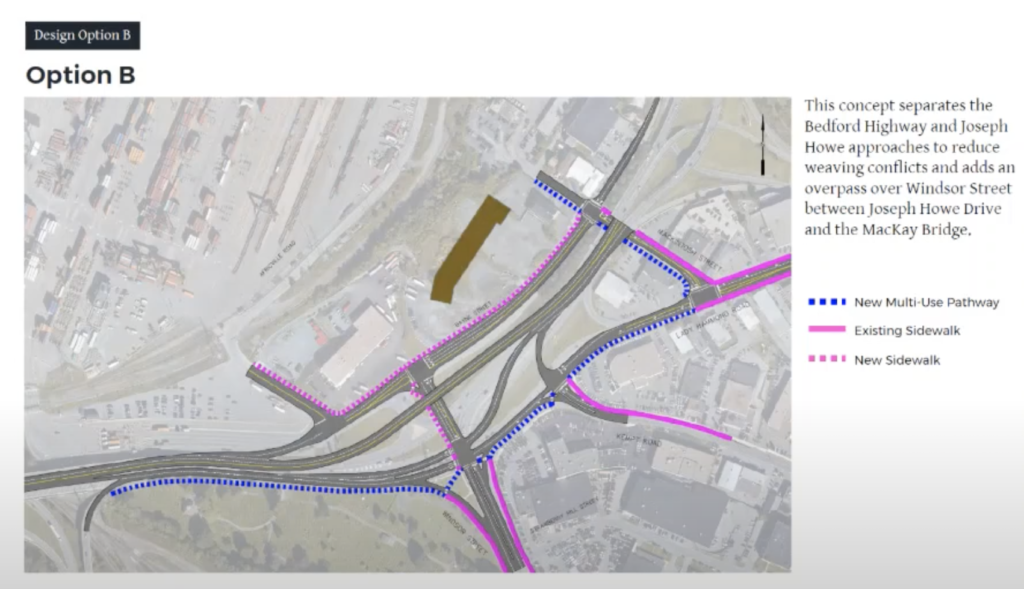The second phase of pubic engagement on the Windsor Street Exchange (WSE) Redevelopment Plan ended last week on November 17. During this engagement period, the city presented two concept designs and gathered public feedback.
The Halifax Cycling Coalition and Bicycle Nova Scotia responded with a letter to address some serious concerns about the plan’s lack of consideration for active transportation, public transit and the safety of all road users.
But first, some background on the project.
About the WSE Redevelopment Project
The Windsor Street Exchange redevelopment project involves the redesign of the intersection of Bedford Highway, Windsor Street and Lady Hammond Road. It is an important access point to the Halifax Peninsula and downtown core.
The city presented two designs, which can be seen in greater detail in this video. Option A features two roundabouts and a multi-use path. It separates higher volume movement using bridge structures, allowing traffic to bypass busier sections. The design features a combination of multi-use pathways and sidewalks with several (six) push-button crossings.
Option B has five intersections with signals that direct more traffic to side streets. It also includes a combination of multi-use pathways and sidewalks with several (six) push-button crossings.


According to HRM’s Windsor Street Exchange Redevelopment Project webpage, the project goals are:
- To add active transportation connections
- To add transit priority measures through the intersection
- To improve the movement of vehicles and goods through the area
- To improve the safety for all road users
Complete Streets, IMP and Centre Plan
The project is meant to follow the Complete Streets Checklist approach found in Appendix D of the Municipal Design Guidelines, recently given First Reading by the Regional Council. Complete Streets are designed to meet the needs of all users, of all ages and abilities. The Complete Streets principles have their foundation the Integrated Mobility Plan Pillars: Connected, Affordable, Healthy and Sustainable.
The project is also within the area of the recently approved Regional Centre Plan with its core concepts of Pedestrians First, Human-Scale Design, Complete Communities and Strategic Growth.
While Halifax has made significant progress on implementing the Integrated Mobility Plan (IMP) to improve movement and help reduce Halifax’s significant transportation emissions, the proposed changes to the Windsor Street Exchange are a concern for sustainable transportation advocates in Halifax.
The main cause for concern? There is a clear prioritization of vehicle traffic in the designs presented. The current WSE proposals do not prioritize people cycling and walking, nor do they prioritize people travelling by transit.
Who Really Has Priority?
As stated by the local transit advocacy group, It’s More Than Buses (IMTB), there is a lack of consideration for public transit that is fast, frequent, and reliable in the proposed designs.
The WSE is one of only five road entrances on and off the Halifax Peninsula. For that reason, the WSE is always likely to be a choke point where private vehicle congestion prevents public transit from running fast and reliable schedules. For this reason, transit priority should be planned for from the very beginning.
As IMTB points out, Design Option A provides no transit priority measures whatsoever through the WSE. Design Option B is somewhat better since it allows for the possibility of keeping buses out of congestion with queue jump lanes and signal priority. However, those measures are not actually planned under Design Option B, but are considered merely possibilities for the future.
You can read IMTB’s full response to the redevelopment plan here.
The Centre Plan, in its Mobility section, has objectives to “Prioritize the needs of pedestrians, cyclists, and public transit users” and to “enhance and extend pedestrian corridors and pathways to provide safe and convenient connectivity within, to, and from the Regional Centre.” The WSE design does not adequately meet these objectives as a multi-use path is both less desirable and less safe than separated routes for cyclists and pedestrians. A multi-use path allows for different users to share the same space. On an urban street, this will include people on bikes, people walking, people pushing strollers, people rolling in their wheelchairs, people skateboarding, and perhaps even people on e-scooters and e-bikes. The problem with this is that different users go at different speeds, making it unsafe for all active transportation modes to mix. When there is a high volume of users on a multi-use pathway, the pathway is no longer a viable option. We believe there will be a high enough volume of users to warrant separated infrastructure.
Based on the proposed design, it is clear that the vehicle traffic lanes were placed first and the ‘priority’ needs are instead an afterthought. This does not appear to be consistent with the direction given by either the recently adopted Centre Plan or IMP, nor is it forward-thinking in terms of low emission transportation design.
The proposed design is not built at a Human Scale, as outlined in the IMP. Human scale means that people can expect to move safely and conveniently in the Regional Centre. To street design, this implies protected routes (sufficiently wide sidewalks and bike lanes) that provide reasonably direct routes to perform out-of-home activities, in an environment of vehicles moving at urban, not highway, speeds. Lower speeds result in significantly lower injuries/fatalities during a driver/pedestrian collision.
Both designs clearly prioritize the flow of traffic and the angles of roundabouts and retention of slip lanes show that the level of safety for vulnerable road users will remain low with these designs. There is no justification for the WSE to be built like a highway interchange; this is the Regional Centre of HRM and needs to be designed as such.
The proposed design fails to reach the objectives that it has outlined, instead, it focuses on improving motor vehicle movement. We are disappointed that in the global climate crises, with what we know about induced demand, we aren’t seeing an option that increases capacity for goods movement and transit movement, without a corresponding increase in capacity for single occupancy vehicles.
If HRM is to meet the objectives it has set out in the IMP, the Centre Plan and for this project, it will need to develop a new concept design that uses the space to prioritize goods movement, transit, and active transportation, rather than one that improves the movement of single-occupancy vehicles.
Read the Letter submitted by HCC and BNS
Learn more about the Windsor Street Exchange and watch the virtual open house





